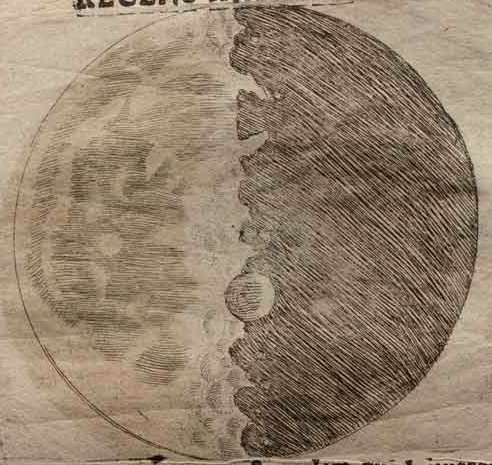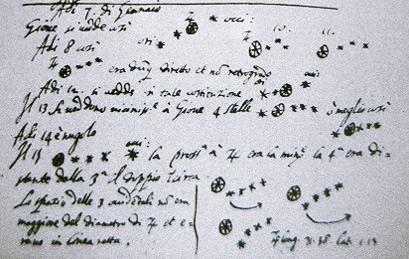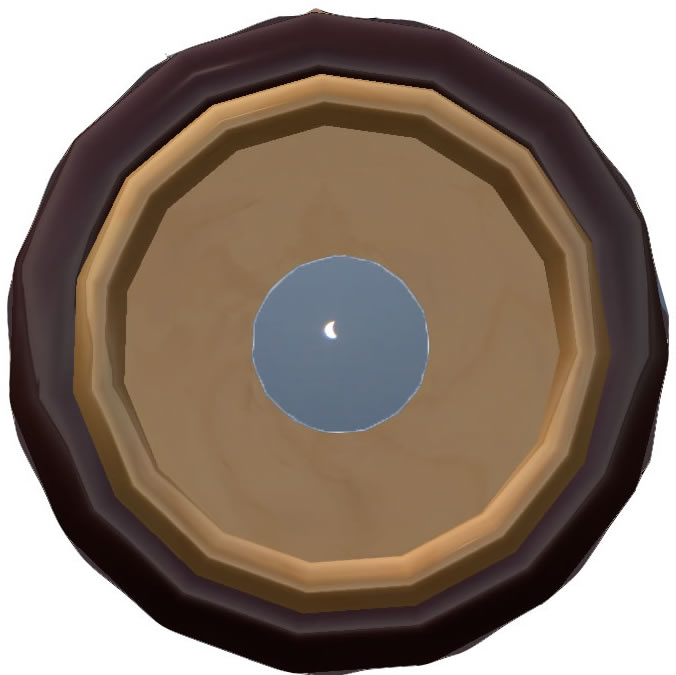Views That Changed the World
Galileo did not invent the telescope (see The Many Inventors of the Telescope). However, as a skilled craftsman he made instruments that were significant improvements over existing spyglasses. Beginning in 1609, Galileo turned his telescope skyward and discovered new truths about the moon, Venus, Jupiter, Saturn, the sun, and the Milky Way. With new evidence, the old model clearly no longer worked.
To experience Galileo's epiphany, read the original text of The Starry Messenger, translated here into English. Galileo's original drawings support his observational claims and convictions.

 Galileo notes the moon--a perfect crystalline sphere, per Aristotle--has obvious imperfections. Mountains and valleys are revealed as shadows migrate across the moon. With simple trigonometry, Galileo even calculates the heights of mountains on the moon. (Image sizes shown are not necessarily to scale.)
Galileo notes the moon--a perfect crystalline sphere, per Aristotle--has obvious imperfections. Mountains and valleys are revealed as shadows migrate across the moon. With simple trigonometry, Galileo even calculates the heights of mountains on the moon. (Image sizes shown are not necessarily to scale.)

 Jupiter yields some of the greatest insights for Galileo. Up to four objects in a row appear left and right of the Jovian disk, suggesting they orbit the distant planet. With four things going around Jupiter, Earth is no longer the immutable center of everything. If Jupiter can carry four moons with it as Jupiter orbits the sun, Galileo reasons, then the Earth can carry its moon with it, too, as Earth orbits the sun.
Jupiter yields some of the greatest insights for Galileo. Up to four objects in a row appear left and right of the Jovian disk, suggesting they orbit the distant planet. With four things going around Jupiter, Earth is no longer the immutable center of everything. If Jupiter can carry four moons with it as Jupiter orbits the sun, Galileo reasons, then the Earth can carry its moon with it, too, as Earth orbits the sun.
With his scope magnifying up to 30 times, Galileo sees Saturn as a three-body system. Shown above is Galileo's sketch from 1616. His telescope is not sufficient to resolve the feature as rings.

 Extended views of Venus show the planet has phases akin to the moon. Unlike the moon, the angular size of the respective phases varies, supporting the notion that Venus passes between the Sun and the earth as the planets revolve around the sun. See NASA activity at Venus Phases: Why Does Venus Look Like The Moon?.
Extended views of Venus show the planet has phases akin to the moon. Unlike the moon, the angular size of the respective phases varies, supporting the notion that Venus passes between the Sun and the earth as the planets revolve around the sun. See NASA activity at Venus Phases: Why Does Venus Look Like The Moon?.
Note: Galileo's view through his telescope is much more challenging than conveyed here. See a simulated telescope view by Jim and Rhoda Morris, creators of a high-quality replica of Galileo's telescope.
Below: When Galileo looks at the three belt stars of Orion the Hunter, highlighted in yellow, he discovers dozens of additional stars. Similarly, the Milky Way holds "innumerable stars."


The"fixed star" Galileo noted to the upper left of Jupiter in 1612 was actually Neptune.

Conveying the Brilliance of Galileo
 The Galileo Project has significant information about Galileo, his contemporaries, and his times. Also, the Institute and Museum of the History of Science (IMHS) produced an excellent online museum exhibit and a series of videos (samples below) that illustrate the vision and achievements of Galileo.
The Galileo Project has significant information about Galileo, his contemporaries, and his times. Also, the Institute and Museum of the History of Science (IMHS) produced an excellent online museum exhibit and a series of videos (samples below) that illustrate the vision and achievements of Galileo.
- Jovilabe
- Venus and anagram
- Milky Way
- Heights of lunar mountains
- Helioscope
- Galileo's micrometer
- Celatone tub
- Saturn's rings
See more of what Galileo saw at http://www.pacifier.com/~tpope/Photo_Drawing_Comparison_Page.htm.
Revisit Galileo's Villa in Second Life

 If you can't visit Galileo's villa in Arcetri, just outside of Florence, then you can teleport to a 3D recreation of the villa's courtyard in Second Life. The SL build resides on the Astronomy 2009 island. Find the large structure which looks like a cross between an igloo and a Starlab dome, and it may be hovering overhead. Stroll or fly from the front entrance to the end of the Great Hall. Continue toward the dome, like Agent Maxwell Smart walking through the lensing door. Approach the console labeled INFO and select Galileo's Courtyard or other destination to rez in the dome. Sit at Galileo's scope and contemplate. Have fun.
If you can't visit Galileo's villa in Arcetri, just outside of Florence, then you can teleport to a 3D recreation of the villa's courtyard in Second Life. The SL build resides on the Astronomy 2009 island. Find the large structure which looks like a cross between an igloo and a Starlab dome, and it may be hovering overhead. Stroll or fly from the front entrance to the end of the Great Hall. Continue toward the dome, like Agent Maxwell Smart walking through the lensing door. Approach the console labeled INFO and select Galileo's Courtyard or other destination to rez in the dome. Sit at Galileo's scope and contemplate. Have fun.
Design of the Let There Be Night structure in Second Life is by Itazura Radio (SL) of Primagination Factory, based on photographs by Jim Sweitzer.
 Images excerpted from Galileo's Siderus Nuncius, or Starry Messenger; are from the Rare Book Room, courtesy of the Warnock Library and Octavo Corporation. Other images have yet to be attributed, with apologies (to IMHS, e.g.) for the delay. Second Life telescope modeled from replica; courtesy of Jim and Rhoda Morris.
Images excerpted from Galileo's Siderus Nuncius, or Starry Messenger; are from the Rare Book Room, courtesy of the Warnock Library and Octavo Corporation. Other images have yet to be attributed, with apologies (to IMHS, e.g.) for the delay. Second Life telescope modeled from replica; courtesy of Jim and Rhoda Morris.


